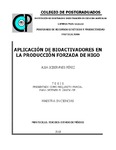| dc.description.abstract | La demanda del higo crece anualmente en el mercado nacional e internacional. México tiene potencial para convertirse en importante productor mundial; para lograrlo, es necesario aumentar el rendimiento, adelantar las cosechas y obtener frutos de calidad. La maduración de los siconos en la planta es escalonada, esto representa una desventaja económica porque comercialmente, es importante concentrar el mayor número de higos maduros para reducir la frecuencia de cosechas. Se ha demostrado que la aplicación de bioactivadores (biorreguladores y bioestimulantes) aceleran el desarrollo de los frutos y, mejoran el rendimiento y la calidad. Por ello, el objetivo de esta investigación fue adelantar la cosecha, incrementar el rendimiento y producir higos con buena calidad, mediante la aplicación de cinco combinaciones de bioactivadores en diferentes concentraciones: thidiazuron, ácido giberélico, ácido glutámico, triptófano y tiamina. Se utilizaron plantas de higo ‘Netzahualcóyotl’ cultivadas en invernadero. Los tratamientos se aplicaron, por aspersión dirigida, a las yemas secundarias axilares en reposo. Las variables evaluadas fueron: brotación de yemas, crecimiento del fruto y rendimiento. Al momento de la cosecha se evaluó la longitud, el diámetro y el peso del fruto, color de la epidermis, firmeza, sólidos solubles totales, acidez titulable y la relación azúcar/ácido. Los resultados indican que los bioactivadores adelantaron 15 días la fecha de cosecha. En los frutos se incrementó el contenido de sólidos solubles totales (±5 a 10 °Brix), la longitud (±1 cm), el diámetro (±0.5 cm) y el peso individual (±5 a 20 g) con respecto al testigo. El color se afectó en forma negativa; los higos con bioactivadores presentaron zonas verdes e inmaduras en áreas cercanas al cuello. El rendimiento no presentó diferencias significativas (p>0.05). En conclusión, aunque los tratamientos con bioactivadores adelantaron la cosecha e incrementaron algunas variables de calidad en higo, ninguna combinación incrementó el rendimiento. __________ APPLICATION OF BIOACTIVATORS IN THE FORCED PRODUCTION OF FIG. ABSTRACT: The demand for fig grows annually in the national and international market. Mexico has the potential to become an important world producer; to achieve this, it is necessary to increase yield, advance harvests and obtain quality fruits. The maturation of the syconium in the plant is staggered, this represents an economic disadvantage because commercially, it is important to concentrate the greatest number of ripe figs to reduce the frequency of harvests. It has been demonstrated that the application of bioactivators (bioregulators and biostimulants) accelerate the development of fruits and, improve yield and quality. Therefore, the objective of this research was to advance the harvest, increase the yield and produce figs with good quality, by applying five combinations of bioactivators in different concentrations: thidiazuron, gibberellic acid, glutamic acid, tryptophan and thiamine. Fig 'Netzahualcoyotl' plants grown in greenhouse were used. The treatments were applied, by directed spray, to the axillary buds at rest. The variables evaluated were bud break, fruit growth and yield. At the time of harvest, the length, diameter and weight of the fruit, color of the epidermis, firmness, total soluble solids, titratable acidity and the sugar / acid ratio were evaluated. The results indicate that the bioactivators advanced the harvest date by 15 days. In fruit, the total soluble solids content (± 5 to 10 ° Brix), the length (± 1 cm), the diameter (± 0.5 cm) and the individual weight (± 5 to 20 g) were increased respect to control. The color was affected in a negative way; figs with bioactivators presented green and immature areas near the neck. Yield did not show significant differences (p> 0.05). In conclusion, although the treatments with bioactivators advanced harvest and increased some quality variables in fig, no particular combination increased yield. | es_MX |


